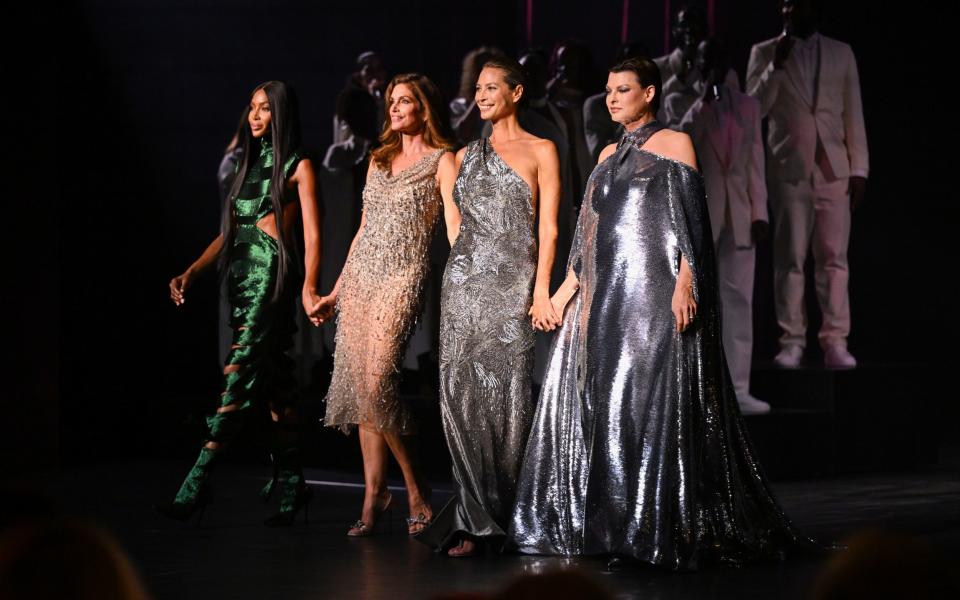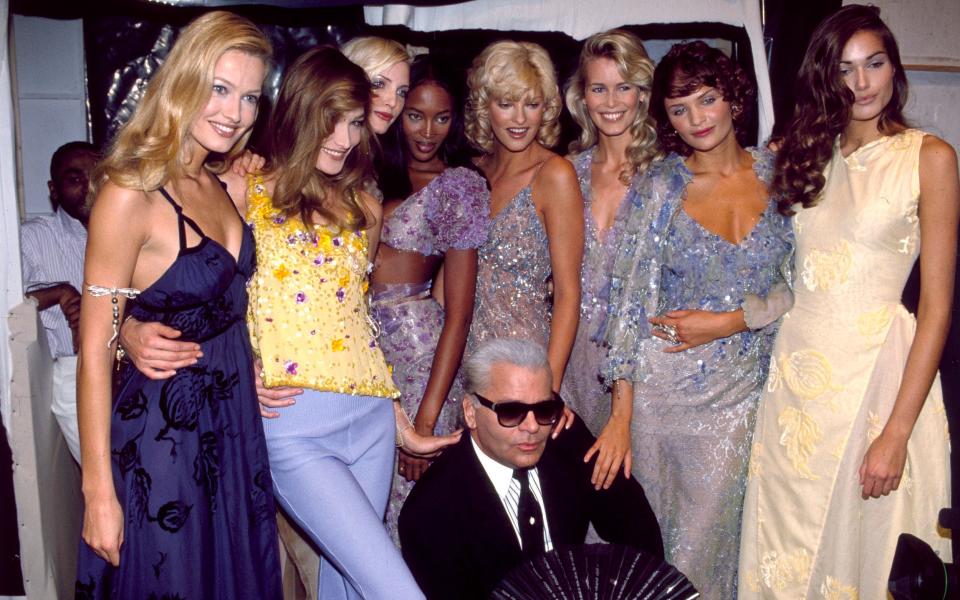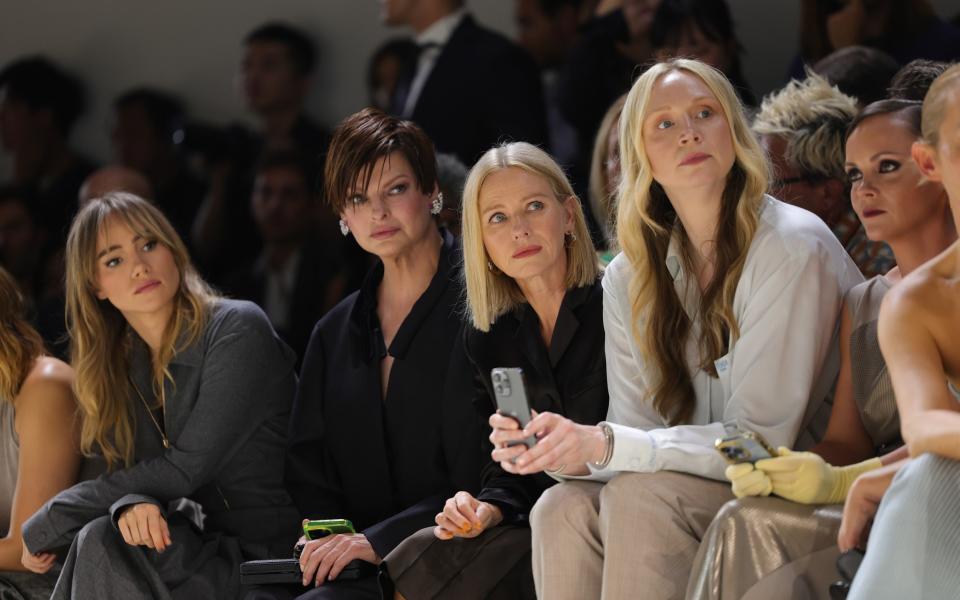Linda Evangelista: supermodel, recluse and incredible comeback queen

The Spring/Summer 2024 season is almost at a close, dahlings. That is, the bi-annual womenswear showcases in London, Milan and Paris where a small percentage of industry insiders see the new season collections from the world’s biggest designers, with all the celebrity froth and fashion dramas that entails.
But alongside the tears at Alexander McQueen (with its designer Sarah Burton bowing out gracefully) and star power of the Dior “frow” (that’s short for the “front row” beside the catwalk, where the A-listers sit), a more human story has been the dignified re-emergence of one of the industry’s most loved figures: Linda Evangelista.
Now 58, Evangelista defined the supermodel era of the 1990s, her celebrity extending well beyond fashion’s usual reach. She and her fellow “supers” became a byword for glamour, so well-known just their forenames sufficed to announce them: Linda, Naomi, Cindy…

But in Evangelista’s case, that rise was to precede a dramatic fall, as the model suffered a series of personal traumas - traumas she has recently begun to open up about after years of silence.
She has spoken, for instance, about her battle with breast cancer back in 2018, resulting in a double mastectomy. It was prompted by a routine mammogram.
“Please do not skip your annual mammograms. Early detection is everything,” she recently told the Wall Street Journal. “Every time you go, you think, ‘Is this the time they’re gonna find something?’ And it was: ‘We think we see something, we want to get more images’. The room starts to spin.” She made the decision to undergo the double mastectomy “because I did not want breast cancer to kill me, and I thought I was taking care of it”.
Despite such radical surgery, she was subsequently diagnosed with another form of cancer – of the pectoral muscle – which, as she detailed to the WSJ, she discovered from rubbing her chest to calm herself after hearing the news that her 16-year old son had gone missing during a school trip (he was subsequently found safe). After that discovery, she endured rounds of chemotherapy that left her feeling “half dead”.

Yet her health battles weren’t over. In 2021, the supermodel revealed on social media that she was suing beauty company Zeltiq after being left “permanently disfigured” and laden with self-loathing by a cosmetic procedure called CoolSculpting, designed to eliminate fat cells, which created bulges around her chin, thighs and bra area.
Her neck was noticeably covered up by a head scarf when she appeared on the front of Vogue’s September issue in 2022.
Having battled chronic lung conditions and escaping what she claimed was an “abusive relationship” with Gerald Marie, a French former model agency svengali, it felt like an especially cruel twist in the fashion fairytale. Marie was later accused by several women of committing rape and sexual assault during the 1980s and 1990s. He denied the allegations and French prosecutors closed the investigation in February this year due to the statute of limitations.
In a recent profile of Evangelista and her fellow supermodels in Vogue, to promote a new documentary series about them on Apple TV+, it was revealed that she’d battled depression following a stillbirth in 1999, and that her son Augie, born seven years later to then partner François-Henri Pinault, the Kering luxury conglomerate magnate, suffered from a sensory processing disorder that made him unable to chew food. More recently, she told Vogue, she’s struggled with OCD and intense germaphobia, so much so that she’s moved homes.
But Evangelista, whose career is the subject of a new coffee-table book by her long-time collaborator, the photographer Steve Meisel, has firmly retaken her place in the front row and the catwalks she’s been absent from for so long.

“Straight from the get-go, Linda was just so versatile,” says the Telegraph’s Head of Fashion Lisa Armstrong, remembering the early 1990s when Evangelista and her peers were breaking new ground. “Linda took it seriously. It was work hard, play hard and she really grafted; she sent herself off to modelling school as a youngster, she treated modelling like a craft and she wasn’t blasé about it.” Soon, the world was noticing.
For fashion purists, Evangelista is the definitive supermodel. Emerging from the backwaters of Canada in the 1980s, her feline eyes and sculptural cheekbones gave her star status in the constellation.
The term “supermodel” evolved in the 1990s to describe the new breed of models imbued with personality in spades. There had been other standout models throughout the decades; Donyale Luna, Dovima, Carmen Dell’Orefice, Twiggy. Kate Moss came later, as part of the problematic “heroin chic” period. But the supermodels hit a perfect Venn diagram sweet spot somewhere between celebrity, women power and fashion. There was none of the waifish blankness of the 1960s and 1970s; their bodies were powerfully athletic and Amazonian, the hair was backcombed and buoyant and the personalities behind the camera evident.
Naomi had her walk and no-one, and I mean no-one, can prowl down a catwalk like Naomi. Cindy had her mole – little girls were known to replicate it – and her All-American bombshell appeal. But Evangelista was their reigning queen. It helped that she’d uttered one of the defining phrases of that decade of excess, in an interview with Vogue in 1990 where she quipped, “we don’t wake up for less than $10,000”.

Evangelista was mythic; despite being as Canadian as maple syrup, she had an almost Italian sense of La Dolce Vita glamour that made her veritable catnip to the country’s grand masters of style; she was muse to Gianni Versace, who cast her in Versace campaigns and as the star of his catwalks. The time Linda, Naomi, Cindy and Christy stormed down the Versace runway in primary-hued babydoll dresses, miming the words to George Michael’s Freedom!, the video in which they all starred, remains etched in fashion history.
When the late, great Liz Tilberis took over the US version of the magazine Harper’s Bazaar, her only goal for her debut cover in 1992 was that it would be Evangelista, shot by Patrick Demarchelier. She got her wish. “Linda could transform from red-haired 1950s pin-up to the face of grunge,” says Armstrong; in the early 1990s Evangelista was the star of Marc Jacobs campaigns at Perry Ellis, where he ushered in the “grunge” era and in which he doused Evangelista in buckets of water for the shots. “I can’t think of any other model in her group who could transform as effectively as she did,” adds Armstrong.
In 1989, cult hair stylist Julien d’Ys cut her hair into a gamine, icy bob; the “Linda” cut, as it became known, was a precursor to the “Rachel” (of Friends’ fame) in terms of popularity.
The original line-up of supers had all been highly visible over the years: Naomi, quick of temper, not without controversies but always a presence on the catwalks; Cindy and her high profile husband Randy Gerber part of an international A-list set that includes George Clooney; and Christy Turlington becoming a poster girl for yoga and charity work.

But Evangelista retreated to the shadows, something of a Norma Desmond figure, while her peers carried on. It wasn’t until 2018 that questions started to be asked; Donatella Versace had staged a gold-dusted reunion of the supermodels on her catwalk and the omission of Evangelista – the ultimate supermodel and Versace golden girl – raised eyebrows. The more misogynist and toxic pockets of the internet generated cruel memes, based on unflattering paparazzi shots of Evangelista, about her not being invited due to weight gain.
We now learn that around this time the model was actually battling breast cancer. Yet, thanks to a groundswell of support from the industry, and subsequent shoots in Vogue, she has begun to come out of hiding.
It is a re-emergence that has been gradual, with Evangelista taking baby steps where once she stormed purposefully. But, last year, Kim Jones featured her in a one-off Fendi show in Milan, wrapped in a confection of Tiffany blue silk; where once Evangelista shied from prying paparazzi, she smiled for the catwalk photographers once again. “I got tired of hiding”, she explained to the Wall Street Journal. “I didn’t want to be miserable any more. I wanted to live again.”
This second coming has been completed over the past month at the whirlwind of spring/summer fashion shows. Where so recently she was absent, she has rejoined the throng. This season has been Evangelista’s most visible and public-facing in years. The clothes have changed – soft structure and more muted – but the woman within them has as much presence and magnetism as she always did. Welcome back Linda, and set the alarm. Those early morning wake ups – at $10,000 or not – are back on the agenda.


